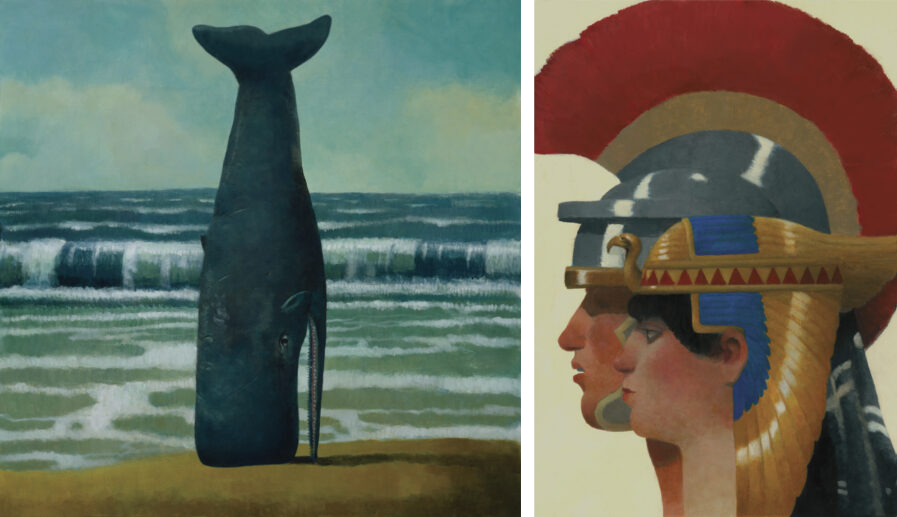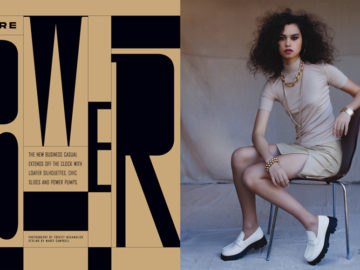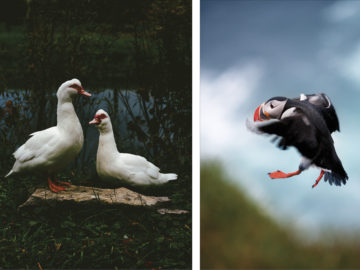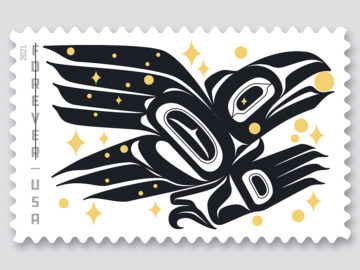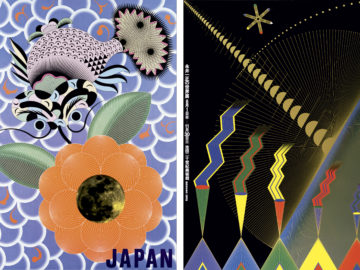In an insightful Q&A session, illustrator and artist Brad Holland delves into the depths of his artistic journey, philosophy, and the notable milestones that shaped his career. Opting for a non-traditional path post-high school, Holland’s ambition to pursue art led him to groundbreaking opportunities, most notably with Playboy, which propelled his career forward. He introduces his unique work philosophy that challenges conventional illustration norms, emphasizing text and imagery’s independent yet complementary nature. Reflecting on the influence of mentorships and personal experiences on his creative process, Holland’s narrative confirms his commitment to innovation and the power of art in storytelling. His collaborations with prestigious publications and contributions to conceptual illustration highlight a career marked by the relentless pursuit of creativity and artistic integrity.
Introduction by Ted Forbes, Founder, Forbes Studio
Most people familiar with Brad Holland can clearly see that he consistently operates with an extreme level of skill as a painter. This is the aesthetic. But more importantly, Brad is a thinker—when he puts the brush to the canvas, he has something to say. Brad’s works are never what you presume, which is what makes him the artist that he is. There’s always something unexpected—something we haven’t seen over and over. Metaphor is probably one of the most difficult visual communication devices to pull off, and he makes it look like it’s easy. I think he’s just wired differently this way. It’s amazing to see him do it. Yes, his technical skills are better than half of his contemporaries, but what makes a Brad Holland piece stand out is the idea. The term “visual communication” has been an industry line for years. Brad’s work defines this. It sets the bar. He does this on an intellectual level, but the result is only achieved by the human element that he conveys. It’s the perfect marriage. He doesn’t overshoot the viewer. He meets them with the idea. You understand every illustration without needing a word of copy. No offense to copywriters; it just makes the concept even stronger when words combine with work on point.
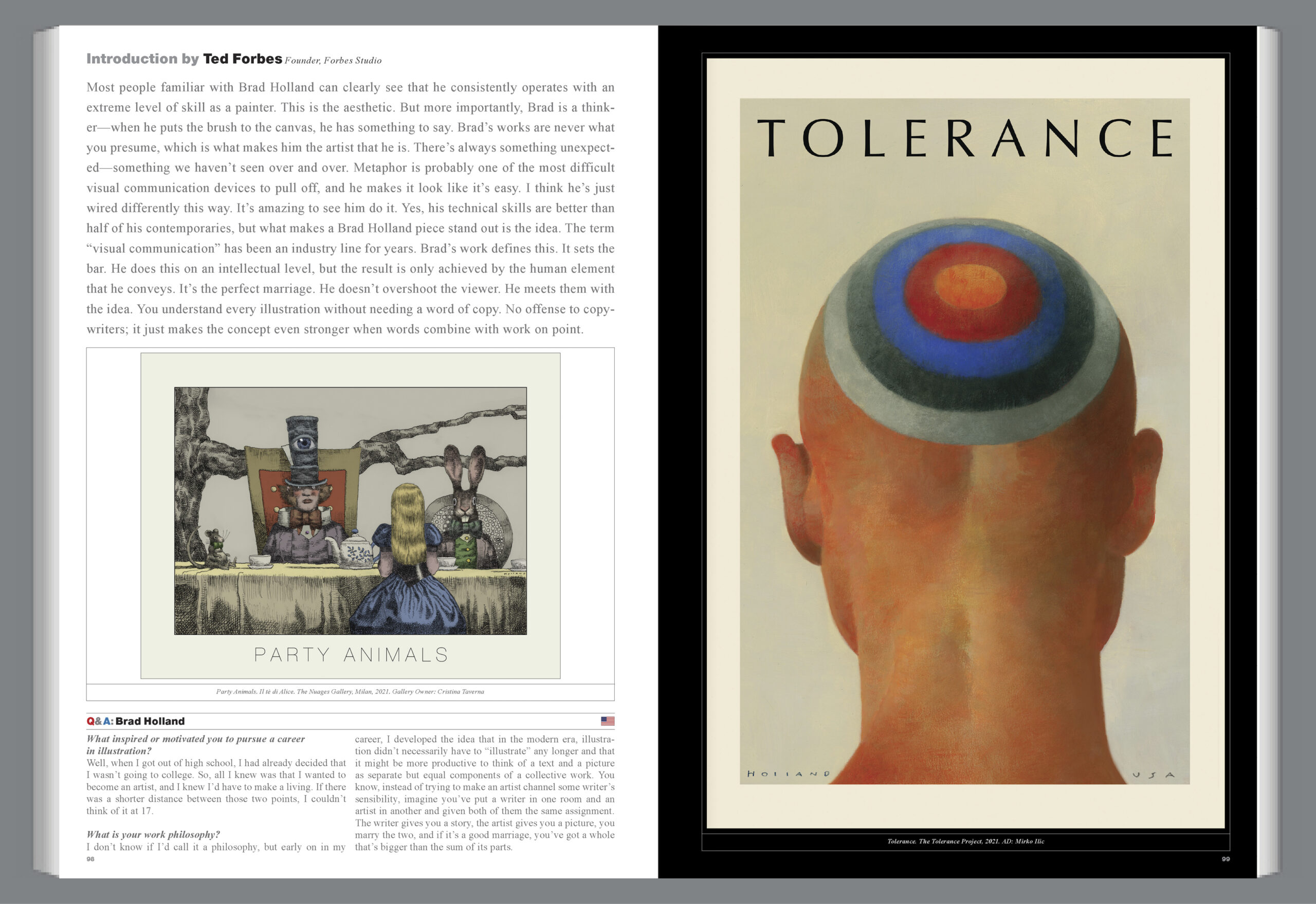
What inspired or motivated you to pursue a career in illustration?
Well, when I got out of high school, I had already decided that I wasn’t going to college. So, all I knew was that I wanted to become an artist, and I knew I’d have to make a living. If there was a shorter distance between those two points, I couldn’t think of it at 17.
What is your work philosophy?
I don’t know if I’d call it a philosophy, but early on in my career, I developed the idea that in the modern era, illustration didn’t necessarily have to “illustrate” any longer and that it might be more productive to think of a text and a picture as separate but equal components of a collective work. You know, instead of trying to make an artist channel some writer’s sensibility, imagine you’ve put a writer in one room and an artist in another and given both of them the same assignment. The writer gives you a story, the artist gives you a picture, you marry the two, and if it’s a good marriage, you’ve got a whole that’s bigger than the sum of its parts.
How did you happen to develop that idea?
Well, like most things, it happened in stages. The hard part was convincing art directors that I wasn’t delusional in thinking that the idea might have some merit. Luckily, I did find an art director fairly early on who I persuaded to give me a shot. And I was doubly lucky because it just happened to be the art director of the highest-paying magazine in the world.
And that would be…
Art Paul, the founding art director of Playboy. At that time—1967—Playboy was just emerging from its early incarnation as a girlie magazine and was on its way to a circulation of over seven million. They had just hired Robie Macauley from The Kenyon Review as fiction editor, and he brought with him a whole posse of famous writers like Saul Bellow, Isaac Singer, John Updike, and so on—that was the start of the old joke about people buying Playboy for the articles—as well as Art Paul, who had been there with Hugh Hefner from the beginning and had complete autonomy about the art that went into the publication. He gave me a trial assignment to see if I could do the kind of thing I had proposed. It was a double-page spread for an article by PG Wodehouse. And when that worked out well, he offered me a monthly feature to see what I could do with it.
The Playboy connection did almost everything at once for me. First, it paid extremely well. Art paid me $1,800 for the first piece—the Wodehouse article—which I looked up on an inflation calculator: it would be $16,500 in today’s money, and I got $1,000 a month for the Ribald Classic feature that I began doing every month after that. That would be $9,000 a month today. So, with one swoop, Art had given me financial security and a high-profile platform to experiment with. Within two years, The New York Times called me to see if I’d be interested in adapting my approach to a new editorial page they were developing (to be called the Op-Ed Page), and when I explained my idea for marrying pictures to articles to the editor, Harrison Salisbury, that became the premise for the editorial art that the Times began publishing.
So do you believe the Op-Ed Page was as important as Playboy in mainstreaming the idea of conceptual illustration?
Not as important, I’d say, but maybe more influential—because with the Times, the subject matter wasn’t limited to articles about love and sex (as they were in the Ribald Classic series), and the drawings that appeared there were seen by lots of people who might otherwise not be caught dead reading a so-called men’s magazine.
Would you consider Art Paul your greatest mentor?
Oh, definitely. And it’s odd because our backgrounds couldn’t have been more different. Art was about 20 years older than I was, had grown up in Chicago, and had been schooled in the Bauhaus tradition of combining the worlds of crafts and fine art. I came from a little town in Ohio with no more art education than a ninth-grade art class. But somehow, by the time I showed him my work, we had come to share the idea that graphic art should somehow aspire to the same kind of integrity as fine art; I’ve always imagined that that was why Art was so quick to take me under his wing. However, since you’ve asked about mentors, there was another guy in the business whose influence was probably just as important to me.
Yes?
A guy named John Dioszegi had hired me right out of high school to work in his studio at a time when I had absolutely no professional experience. When I met John, I had just arrived in Chicago—which in those days was still the second-largest city in the country—and my only “work philosophy” was trying to get a job of some sort. I had never been to a big city before, and I didn’t know how artists earned a living. The newspaper want ads said artists had to know “keyline and assembly” and I didn’t even know what that was. It sounded like a factory job to me—like keypunch and assembly—so I began applying for jobs at art studios by offering to work for free if they’d teach me what keyline and assembly were. I was young and looked younger—a couple of people actually asked me if I was skipping school—and nobody would give me the time of day until I applied at this broom closet of an office on the 28th floor of the 333 North Michigan building, right at the head of Chicago’s Magnificent Mile.
John Dioszegi was twice my age at the time. But, as an artist, he was only a few years ahead of me. He had studied engineering in college and then became a pilot in the Air Force. He then went to art school and, finally, around the age of 30, started a two-man commercial art studio. I had brought a bunch of cartoons with me from Ohio—I had applied for a job at Disney when I was 16 and got rejected—but with all the preparation I had done for that, I was a pretty decent cartoonist at 17. So John hired me on a freelance basis, which meant that I only got paid when we had work—and lots of weeks, we didn’t have any. However, in the process, he taught me the fundamentals of both art and the art business—and a great deal more about becoming a man. John was one of the very few men I’ve ever known who was both great and good, and we stayed friends for the rest of his life.
In what ways do you think your personal experiences and background influence your work?
In every way. With the exception, I suppose, of the cartoons I did as a teenager working for John, I think everything I’ve ever done since has come almost solely from my experiences and my reading.
Can you share an instance where a project had a significant impact on you personally or professionally?
Well, not a project as such, but the work I did at Hallmark was decisive for me.
In what way? When did you work at Hallmark?
I started there when I was 20, after two years in Chicago. Halfway into my first year, Hallmark made me a supervisor and gave me a group of my own to work with on special projects. So, I was doing illustrations for books that the company was just starting to introduce into their product line. They were mostly gift books, things that were in the public domain and which had generally uplifting themes. For example, things like A Christmas Carol, chapters from Les Misérables or The Robe, several Wit and Wisdom of… books (John Kennedy, Pope John XXIII, Abraham Lincoln, etc.), and so on. The job at Hallmark saved me at a time when I was really despondent about the future of the art business and was thinking of quitting to become a writer.
In what way did Hallmark—to use your expression—“save” you?
Well, growing up in Ohio, my influences had almost entirely been a product of pop culture. But in Chicago, with its art stores and book stores, its massive public library, and a great art museum, I’d found that I was absorbing more influences than I could assimilate, and every picture I tried to paint there had become a challenge to embody everything I was learning. I was cramming every painting with imagery that kept changing and evolving as I worked on it, and in trying to master both conception and execution, I was usually making a big mess of everything. I got so frustrated that one Sunday, I collected all my unfinished pictures and burned them in the backyard of the rooming house where I was living. At that point, I wasn’t sure I even wanted to go on.
But at Hallmark, it was all very different. There, the company piled project after project on me, and the tight deadlines helped me clear my head of influences that had been influential just because they were attractive or challenging. The pressure forced me to condense what I had learned in Chicago into nothing more than what I needed for the job at hand. And that allowed me to create an artistic personality that was of myself but larger than me.
The elements all came together for me one rainy Saturday night when I abandoned a large realistic painting I had been working on and, on impulse, did a crude black-and-white drawing of a peg-legged sea captain chained to an anchor in a patch of Queen Anne’s Lace. “Captain Ahab in Kansas,” I thought to myself—stranded in a field of dreams, with more than two thousand miles to the nearest whale. I had no idea where the concept had come from, but over the following year, drawings like that began pouring out of me with imagery so unexpected that I could hardly wait to see what I was going to do next.
At that point, the people who had seen the drawings—which was really only a handful of friends—all seemed to agree that there was nothing quite like them being done in the field of illustration (although there was general disagreement about whether or not that was a good thing). But I was so sure of what I was doing that I decided it was time to leave the Midwest and try my luck in the big leagues. I wasn’t sure that I could sell the pictures to art directors, but I had a feeling that they would sell themselves. And as it turned out, they did.
Since then, your work has appeared in publications such as Vanity Fair, The New Yorker, Time, Playboy, Wall Street Journal, Fortune, Rolling Stone, and The New York Times. Which publication has been the most interesting to work with?
Well, I don’t know about the most interesting. The most important, of course, was Playboy and The New York Times, no question, because they allowed me to develop visual ideas that were initially just instinctive into the kind of thing you could apply to stuff written by other people—and then to see how far I could stretch those concepts before I’d stretched them too far. But as for the most satisfying publication, I’d have to say that was probably—at least for a few years, anyway, before it folded—the Frankfurter Allgemeine Magazin. At the time, somebody referred to it as The New York Times Magazine of Europe.
Back in the 1990s, the art director, Hans Georg Pospiscil, started giving me eight pages and a cover every two months or so to do paintings on various subjects, and then they wrote articles to go with the pictures. Given that kind of freedom, I found myself mixing elements of reportage and imagination in ways that were barely possible with more traditional assignments.
Can you describe a project of that sort, and what did you learn from that experience?
Sure. At one point, they asked me to do a series of paintings about New York City high schools. I started researching by going to Washington Square Park and sketching the kids who hang out there after school. I ended up with sketches of dresses, hairstyles, and attitudes: kids roller-skating, trading drugs, squabbling, or goofing around with each other. But when I started painting, I wanted to do something that went beyond reportage.
For example, one painting was just two kids conversing in front of a wall of graffiti—nothing says New York City kids like graffiti, I thought. But then, when I started defining the wall itself, I thought I didn’t want to just copy the kind of “tagging” that kids were actually doing to the city streets—that “TAKI 183” kind of spray painting that everybody’s familiar with. I wanted to define what the graffiti culture actually was; while I was thinking about that, I remembered that once, when I was a little kid, I sat behind my father’s easy chair one evening scribbling on the wall with crayons. That gave me the idea I wanted for the painting. So, I went out, bought a box of crayons, and began scribbling a lot of scary faces on the wall behind the two school kids, and suddenly I had the kind of painting I wanted. Or at least I had it until the last minute when I suddenly decided it needed something else to complete the scene, and I added a skinny feral dog walking into the picture. It was that kind of thing that the Frankfurter Allgemeine Magazin allowed me to do.
How do you handle creative block or periods of low inspiration?
I’ve never waited for inspiration; it’s not reliable. The trick is to be receptive to inspiration when it does come and then figure out how to channel it and apply what you’ve learned from it to other situations when you need it.
How do you balance staying true to your style with adapting to current trends or client demands?
Those are two different things. As far as adapting to trends, that’s never been an issue with me. I’ve always been oblivious to them. I tend to go my own way. As for clients, I tried to deal with that in the beginning. Once I had Playboy and the Times as regular outlets, I generally didn’t look for high-profile assignments where clients would want to exert a lot of control. So instead, I often took little assignments, often for out-of-the-mainstream publications—and often even worked for free if they’d let me do the kind of art I wanted to do—until, over the long haul, I had created a demand in the marketplace for that kind of work. After that, other clients began calling for the kind of work I was doing, and within a fairly short period, my approach had just entered the mainstream.
Who have some of your greatest past influences been?
There have been so many. In high school, I’d learned to draw comic characters in the Disney style, hoping, of course, to get hired there. But I was also influenced by the drawings of George Woodbridge, a Mad Magazine cartoonist, and the book illustrations of Henry Pitz and Ronald Searle, especially the drawings from life that Ronald was doing in those days for a series of travel books. In Chicago, I started by assimilating Daumier and Lautrec, and later Heinrich Kley, Ben Shahn, Leonard Baskin, Antonio Frasconi, and Hokusai, the Japanese woodcut artist. Later, when I started painting, I studied Edward Hopper, Diego Rivera, Degas, and Gauguin. I was always influenced by a lot of different people, but never by anyone in particular because I could find bits and pieces of myself in lots of others, but never all of myself in anyone else. But, of course, that just accounts for my visual influences. Conceptually, I think I was more influenced by the plays I was trying to write in my late teens and early twenties. I’m sure that accounts for the kind of pictures that I began doing that rainy night in Kansas City and rode into New York City on.
What kind of plays were you writing then or trying to write?
In the beginning, it was mostly satirical things. In high school, I had written and performed in a lot of comic skits until, in my senior year, I discovered Ionesco’s play Rhinoceros. That showed me how you could give dramatic form to ideas that were essentially comic or even preposterous. Then, the next year in Chicago, I discovered the plays of Camus: Caligula and The Just Assassins—which led me to Brecht and Beckett, and then to Marlowe’s Doctor Faustus. Ultimately, I discovered Sophocles and Prometheus Bound by Aeschylus, and the austere style of those old Greek playwrights appealed to me. So, over the next few years, I found myself trying to write conceptual plays of my own in an equally direct style. Most of them were never finished or were abandoned in various fragments. But in the end, the kind of thinking that went into the plays began going into my pictures. And that gave me the kind of direction that, until that, I hadn’t had.
Do you mean you were illustrating scenes from your unfinished plays?
No, no, not that. I meant that my thinking was starting to take a visual rather than a written form.
Well, since you’ve brought up the subject of your writing, tell us about your satire piece, “Express Yourself, It’s Later Than You Think.”
Oh, yeah. It was first published in The Atlantic Monthly.
What’s the story behind it?
Well, on one level, I was just mocking what I regard as the pretentiousness of the fine art world, like calling drawings “Works on Paper.” Or the way some people would have graffiti sandblasted off the outside of their building, then spend thousands of dollars buying graffiti art to hang in their living room. It’s amazing what the pursuit of status can do to some people. In general, it was just a satire on the whole edifice of postmodern thinking. To me, the great “zen question of Postmodernism” is why the original design for a Campbell’s soup can is not a work of art, but an Andy Warhol copy of it is. But for me, the most interesting thing about the article is what happened after it was published. Even though I was satirizing the whole art business, the fact that it was published in a major magazine landed me on a list of art critics to be courted by galleries and museums. Suddenly, they began sending me press kits for their upcoming exhibitions, complete with slides and sample articles that critics could, if they chose, just copy and paste and modify as their reviews. It was just a little window into how the entire fine art business works, and for me, the experience validated the mockery I had expressed in the article.
What about your work gives you the greatest satisfaction?
The pictures that best satisfy my creative instincts are the ones that exist in the no-man’s-land between discipline and freedom.
What do you consider your greatest professional achievement so far?
Finding my own voice so early in my career and being able to create a demand for it in the marketplace.
What professional goals do you still have for yourself?
I’ve been working on a memoir—not a didactic life story or anything like that. It’s mostly just a lot of stories—told mostly in short story fashion—about things I’ve done or people I’ve known: some of the hipsters and cool-daddy-os that I used to spar with in my early days in Chicago, or the week I spent with a bunch of rodeo clowns in the Southwest when I was writing an article about them for Texas Monthly. I’ve got a long account about the weekend I spent with Korczak Ziolkowski out in South Dakota—he’s the guy who was trying to carve a 500-foot-high statue of Crazy Horse out of a mountain, and there’s also the drunken afternoon I spent with Slim Pickens, the cowboy actor, one day at the Saint Regis Hotel, then encountered Salvador Dali in the elevator. It started out to be mostly a book of text with pictures. But once I got started, I had so many pictures I wanted to include that it grew to over 500 pages, which is clearly too long. So I cut it down to 300 pages to show to publishers, and now I have enough left over to start a second memoir.
What do you value most in life?
Character. It’s the one virtue that underwrites all the others.
Brad Holland is a Hall of Fame artist and writer whose most recent book, Geant Endormi (Sleeping Giant), is a collection of 200 drawings published in 2021 by Les Cahiers Dessines. In addition to his editorial and advertising work, he has just finished paintings for It Happened in Salem to be published in 2024 by Creative Editions and Such Stuff as Dreams for a 2024 book and exhibition at the Nuages Gallery in Milan.


